(Brand Story)
How Juju Vera’s Petra Necklace Went Viral With Zero Marketing
It’s probably already on your watchlist.

There it is again: worn over someone’s gown at a fancy gala, peeking out from underneath a stranger’s slouchy suit downtown, or teasing you every time you scroll through social media and Substack. Yes, we’re referring to the Petra pendant, Juju Vera’s distinctive, double take-worthy design that people are lining up for en masse.
The popularity of the sterling silver or bronze necklace, which takes two weeks to solder and polish by hand in New York City, means there are often waitlists for people clamoring for their own unique iteration. “We’ve sold out three times already,” founder and creative director Julia ‘Juju’ Ferentinos tells TZR, in delighted disbelief.
Ferentinos’ love of the type of ornate accessories that speak to a bygone era runs deep. Four years ago, she was operating a small business sourcing vintage jewelry from flea markets around the world and curating her finds for television and editorial projects. Over time, her eye and taste helped her amass a small following on Instagram. When the moment came to dabble in starting her own endeavor, her teaser images caught the eye of Moda Operandi’s Lauren Santo Domingo. (More on that fateful Instagram DM later.)
“I’m not a jeweler, and I’ve no background in jewelry design,” Ferentinos says, speaking from her Manhattan studio where the walls are decorated with her own artwork. “I’m an outsider in that sense, but I have always painted and sculpted with different mediums. I approach jewelry from more of a sculptor’s point of view, or how an artist hones in on shape, proportion, and heft. I like to think about how a design would lay on the body as an adornment.”
To bring the Petra to life, that thought process entailed almost two years of back-and-forth between inspiration, design, and execution. An old image of Mia Farrow at the 1968 Cannes Film Festival premiere of Rosemary’s Baby helped define the size and scale of the pendant and chain. Ferentinos also cycled through both dreamt-up and existing references that spanned seashells, Art Deco motifs, architecture, ‘60s and ‘70s style savants, and nods to her Greek-Roman heritage. “I would then wear test prototypes for a couple of months to really decide on the final shape and curvature,” she recalls. “I wanted to find the balance and juxtaposition between the natural world with something a little more architectural, while also feeling modern.”
Ringing in at $595 and devoid of any diamonds or overt branding, the Petra seems to sit in a sweet spot where it’s both aspirational and attainable. As such, it’s making waves thanks to endorsement from tastemakers everywhere from Copenhagen and London to Paris and New York. But while it’s achieved ubiquity, it’s also still firmly in the IFYKYK category.
On its cross-generational, global, and timeless appeal, Ferentinos says: “I never really designed the collection with a commercial focus, but I was thinking about how I shop for things and how I style myself. I wanted the sculpture of the piece to speak for itself. I was obsessed with the idea of creating mini art pieces that people could wear, and style in unexpected ways to elevate any outfit. I was inspired by thinking of something that a woman in the second century B.C. could have worn to a dinner party, but then how that could translate to something a young girl that’s living in downtown Manhattan would wear to dinner with her friends, too.”
For Ferentinos, who’s in her early 30s, there’s been no shortage of pinch-me moments since launching the brand last July. After Santo Domingo, the founder and chief brand officer of Moda Operandi, came across her digital moodboards, she reached out about purchasing the Thea collar. “I said, ‘You’ve really caught me in the early days but I would love to show you what I’m working on.’ From there, she connected me with the jewelry team, who helped motivate me to get things completed. There was no business plan or plan for how to go to market; it was just a personal project at the start, but I was very passionate about the pieces and how and what I wanted the brand to look and feel and stand for. I am very grateful for Lauren — the industry listens to her and watches who she is supporting.”
When Moda set the Juju Vera trunkshow live on site, the demand and interest for Ferentinos’ cuffs, collars, and collectible pieces like catchall dishes and lighter holders was palpable — and everything eventually sold out. “Sometimes I am on Instagram and I see someone in the industry or an influencer who I have followed for a while, and they’re wearing a Juju piece. It’s so wild to me that they’re buying them,” Ferentinos says. “Everything has been completely organic and through word of mouth — we have not sent one marketing email about the Petra! We really focus on storytelling through imagery online.” (Ferentinos still oversees the visuals and social media herself.)
“I think I’ve always had an eye or a hand for wanting to create things, but I don’t think I ever thought I would be a jewelry designer. But I am fascinated by how these pieces are now living out there in the world and becoming part of people’s stories,” Ferentinos says. “I’m just so happy to see people make the Petra their own and interpret it in their own way — using it as a brooch, a belt, or wearing it on another chain.”
Going forward, she’s keeping that authentic success in mind and ensuring these debut bestsellers are permanent parts of the collection, perhaps incorporating some new design elements or tweaking small details. As we speak, she’s readying for the launch of her sophomore offering, and working on a special collaboration that will be revealed soon. By the sounds of things, you should probably act fast when it all drops.